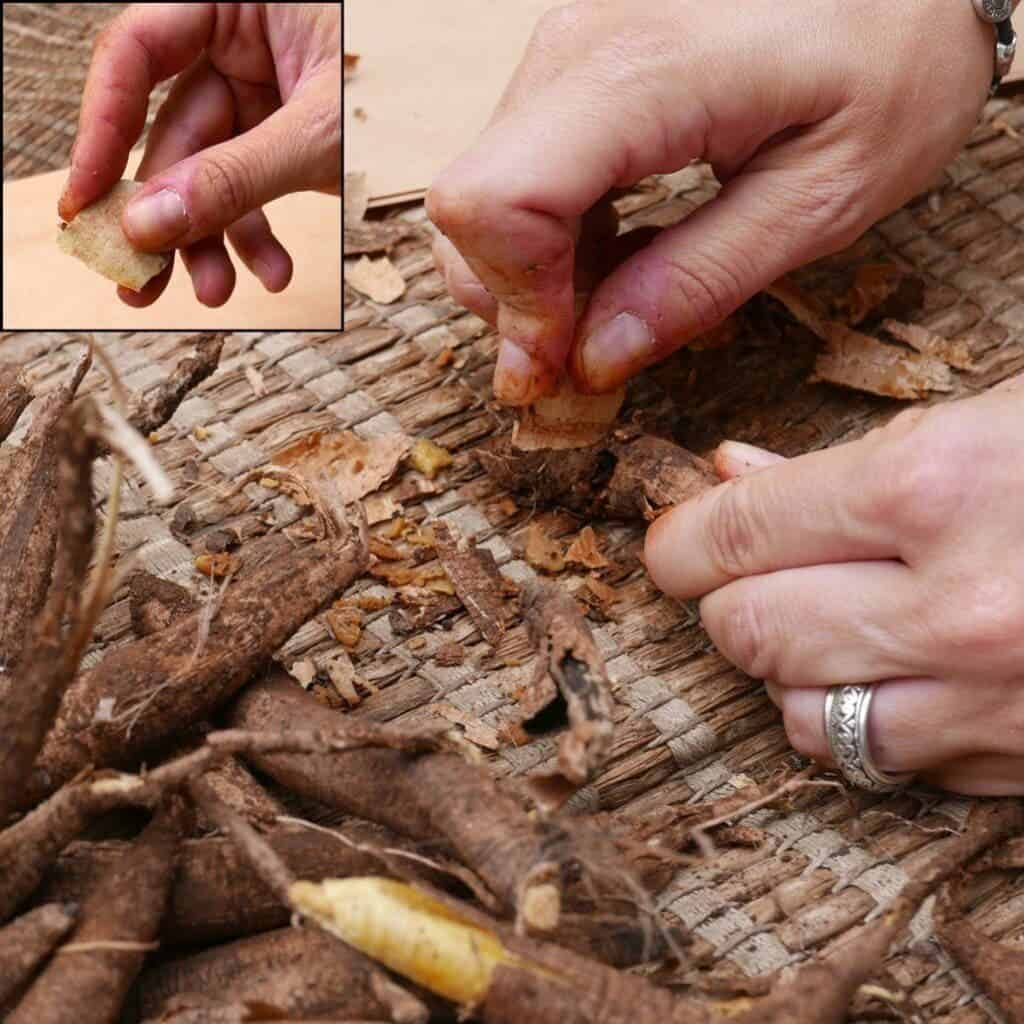Research from Tel Aviv University (TAU) shows that recycling may, in fact, be an ancient tradition. Prehistoric humans deliberately “recycled” discarded or broken flint tools 400,000 years ago to create smaller, more specialized tools.

Tuber cutting with a small recycled flake, alongside a close-up.
Image credits Flavia Venditti / AFTAU.
In collaboration with members from the University of Rome, researchers from TAU’s Department of Archaeology and Ancient Near Eastern Cultures used two different spectrometry methods to analyze small, peculiar tools that have been uncovered at prehistoric sites throughout Europe and North Africa. Their edges show signs of use, the team reports, and were likely used for in food preparation. This theory is also supported by micro residue found embedded in the edges.
Recycling, before it was cool
“Recycling was a way of life for these people,” says Prof. Ran Barkai from TAU, the paper’s corresponding author. “It has long been a part of human evolution and culture. Now, for the first time, we are discovering the specific uses of the recycled ‘tool kit’ at Qesem Cave.”
The site of Qesem Cave is located just outside Tel Aviv. It was discovered during road construction projects which were undergoing in the area in 2000. Together with caves in Spain and North Africa and digs in Italy and Israel, Qesem produced the tiny blades the team analyzed in the study. Along with other material retrieved from these sites, the tiny blades show signs that prehistoric humans recycled broken tools, or those that were no longer needed, into tinier but more specialized blades.
Due to these cave’s microclimates, the flint tools were preserved in excellent condition, along with residue material from their use embedded in their edges — allowing for their proper analysis. The researchers used two techniques to do so: Fourier transform infrared spectroscopy (FTIR) and scanning electron microscopy coupled with energy dispersive X-ray spectroscopy (SEM-EDX).
“We used microscopic and chemical analyses to discover that these small and sharp recycled tools were specifically produced to process animal resources like meat, hide, fat and bones,” explains Dr. Flavia Venditti of the TAU and lead author of the study.
“We also found evidence of plant and tuber processing, which demonstrated that they were also part of the hominids’ diet and subsistence strategies.”
Signs of use were found on the outer edges, the team reports, indicative of cutting activity. Material on the blades suggests that they were used in activities related to the consumption of food: butchery activities and tuber, hide and bone processing.
The team went to great pains to meticulously analyze the tools to “demonstrate that [they] were used in tandem with other types of utensils,” according to Dr Venditti. This would suggest that the recycling was a deliberate process, used specifically to produce a more specialized tool to be used as part of a larger kit.
“The research also demonstrates that the Qesem inhabitants practiced various activities in different parts of the cave: The fireplace and the area surrounding it were eventually a central area of activity devoted to the consumption of the hunted animal and collected vegetal resources, while the so-called ‘shelf area’ was used to process animal and vegetal materials to obtain different by-products,” she adds.
The study touches on two hot topics in the field of stone-age archaeology, looking at both the role of small tools and that of recycling in prehistoric communities. The findings show that recycling was an established, on-going practice at Qesem Cave rather than a more opportunistic process. The people in this area had ample access to flint, the team also notes, so it wasn’t a question of scarcity. Rather, it seems that this group of people deliberately used tool recycling to produce these tiny blades because it was the most effective way to do so. The blades had to be tiny yet sharp, as they were used in tasks where “precision and accuracy were essential,” Venditti concludes
The paper “Recycling for a purpose in the late Lower Paleolithic Levant: Use-wear and residue analyses of small sharp flint items indicate a planned and integrated subsistence behavior at Qesem Cave (Israel)” has been published in the journal Journal of Human Evolution.









